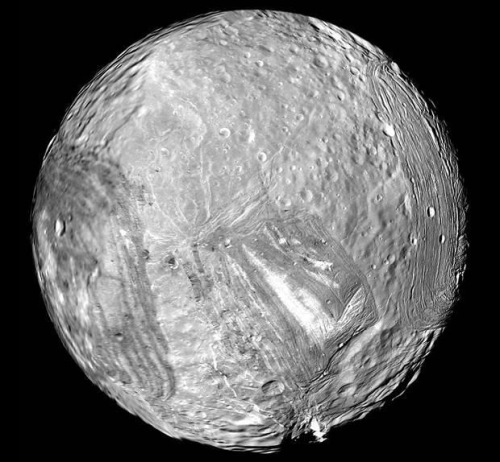
(Uranus’ patchwork moon, known as Miranda, as seen by NASA’s Voyager 2 probe in 1986 – Photo Credit: NASA/JPL-Caltech)
Scientist’s may have finally figured out the reason behind the strange appearance of Uranus’ moon Miranda: the smallest and innermost moon which is often compared to Frankenstein’s monster due to its unusual patchwork surface.
Although Miranda is only 293 miles (471 kilometers) wide, around one-seventh as large as Earth’s moon, it possesses one of the oddest and most varied landscapes known in our Solar System, including a number of giant canyons that are up to 12 times deeper than the Grand Canyon.
“Miranda has a really bizarre, deformed surface,” said Noah Hammond, a planetary scientist at Brown University. “It’s a really beautiful and exotic moon” he added.
Miranda’s surface is made up of regions of broken terrain which are criss-crossed by huge canyons. It also has three giant ‘racetrack’-like grooved structures, known as coronae, on its southern hemisphere. They are each at least 200 km (120 mi) wide and up to 20 km (12 mi) deep and are named Arden, Elsinore and Inverness, after locations in Shakespeare’s plays.
Scientists have long wondered how the coronae formed. One theory was that Miranda may have been disrupted by a catastrophic impact, after which its pieces chaotically reassembled. Another possibility was that the coronae formed when buoyant domes of ice rose, causing Miranda’s surface to crumple as matter was added to it.
But now, researchers believe that the gravitational pull of Uranus may have squeezed and stretched Miranda enough to heat it up, leading its innards to churn and create the coronae.
 (A close up of Miranda’s unusual surface – Photo Credit: NASA/JPL)
(A close up of Miranda’s unusual surface – Photo Credit: NASA/JPL)
When Uranus’ gravity pulls on Miranda, it generates tidal forces, much as our Moon does to Earth. Tidal forces are commonly observed elsewhere in the Solar System, but they can be far stronger than the tidal effects witnessed on Earth. For example, Jupiter’s gravitational pull causes the rock solid surface of its moon Io to bulge by as much as 300 feet (90 meters) and generate enough heat to create volcanic eruptions.
Three-dimensional computer simulations of Miranda, performed by the new study, have now revealed that Miranda’s orbit around Uranus was once oval-shaped, which meant that it moved it much closer to and much farther from Uranus.
The resulting tidal forces from this eccentric orbit would repeatedly stretch and squeeze Miranda enough to generate substantial amounts of heat that would cause Miranda’s icy mantle to churn with convection much like Earth’s mantle. During convection, the moon’s warm buoyant ice would have risen to the surface, contorted it and created the coronae.
The new computer model accurately explains the locations of the coronae and the deformation patterns within the coronae, thus solving the long standing lunar mystery.
Sadly, so far, scientists only know what Miranda’s southern hemisphere looks like. NASA’s Voyager 2 spacecraft flew past the moon during its 1986 Uranus visit, but did not image Miranda’s northern hemisphere.
“It’d be really interesting to think about what could be on the other side of Miranda,” Hammond said. “Our study predicts there’d be one additional corona on Miranda’s other side, and I would love to live long enough for a mission to go back to Uranus and test that hypothesis.”